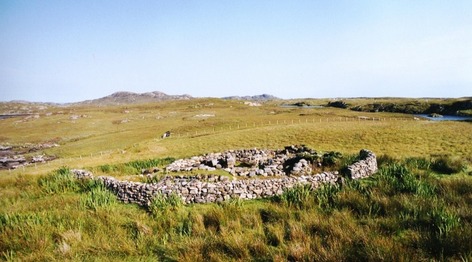A moorland wheelhouse...

View of wheelhouse from the West
The archaeological site at Bagh nam Feadag is an important addition to the archaeology of the Western Isles. This website will describe the archaeological remains found at Bagh nam Feadag, a location on the northern coastline of the island of Grimsay. The structural remains range from the early to late Iron Age through to the medieval and post-medieval periods. The structures, including a wheelhouse which had been modified in antiquity, were uncovered in the 1990s by amateur excavation and are clearly indicative of this area of Grimsay being of significant archaeological importance.
The purpose of this website is to present information on these remains, both structural and artefactual, with the hope of furthering understanding and debate on what is a significant site. Although not excavated in a modern scientific manner, enough detail was recorded to enable an outline of the development of the site to be put forward. The site is important as it is the only one of two wheelhouses to have been excavated in the eastern, peat covered environment of the Western Isles. Many other wheelhouses are sited on the western, machair environment of wind blown shell sand.
The purpose of this website is to present information on these remains, both structural and artefactual, with the hope of furthering understanding and debate on what is a significant site. Although not excavated in a modern scientific manner, enough detail was recorded to enable an outline of the development of the site to be put forward. The site is important as it is the only one of two wheelhouses to have been excavated in the eastern, peat covered environment of the Western Isles. Many other wheelhouses are sited on the western, machair environment of wind blown shell sand.
The island of Grimsay, where the structures referred to in this website are located, is situated between North Uist and Benbecula, adjacent to the ‘North Ford’, which today is crossed by road causeway. Grimsay is a small island even by Hebridean standards, being only 5km long by 3km wide, the typically tortuous coastline gives way to undulating moorland with the highest points being only approximately 25 metres above sea level. The island currently has a thriving community which can be traced back through recorded croft histories to the early 1800s with archaeology providing evidence for habitation prior to this. The area of Grimsay focused upon is Bagh nam Feadag, meaning ‘Bay of the Plover’, taking its name from the Golden or Ringed Plover which is common in moorland and coastal regions of the Hebrides (Angus 2001, 235).
ACCORD - Archaeology Community Co-Production of Research Data
In August 2014 ACCORD, together with the Uist Access Archaeology Group, recorded the Bagh Nam Feadag wheelhouse in 3D using a technique called photogrammetry. Check out the results on the YouTube link below. For more information about ACCORD and the projects they are involved in, have a look at their website: https://accordproject.wordpress.com
3D visualisation by ACCORD/Access Archaeology Group
For further info please contact below:
Thank you, your message has been sent
This is the personal web site of Alasdair McKenzie.
The views expressed here are my own.
Alasdair McKenzie
Copyright © 2009
The views expressed here are my own.
Alasdair McKenzie
Copyright © 2009
